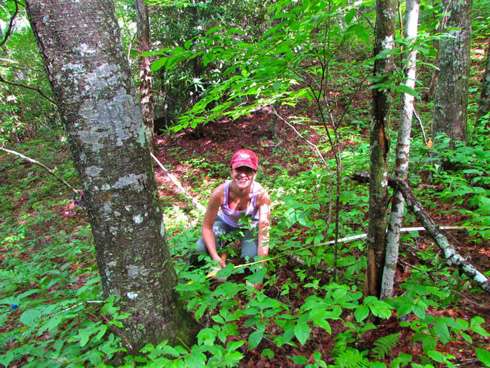Undergraduate studies how rhododendrons invade and conquer by disturbing nitrogen cycle

How important is the soil beneath our feet to what grows above it?
The short answer is very, according to Virginia Tech's Mahtaab Bagherzadeh of Annandale, Virginia, a senior majoring in biological sciences in the College of Science and a 2014 Fralin Life Science Institute Summer Undergraduate Research Fellow.
Bagherzadeh recently participated in a study that discovered invading rhododendrons affect the nitrogen cycle and surrounding plant communities.
In recent decades, rhododendron, an evergreen shrub that grows in large thick patches, has expanded in areas where there has been loss of other plant species. These species, which include hemlocks and chestnuts, have died off due to invasive pests.
In particular, the rhododendron beats out other species because of its control over nitrogen, a chemical element essential for plant growth.
"What we have seen is that rhododendron acts like a native invader because it comes into places where hemlock has died off, and it takes over the soil because of its influence on the nitrogen cycle," said Jeb Barrett, associate professor of biological sciences in the College of Science, Fralin Life Science Institute affiliate, and Bagherzadeh's fellowship advisor.
Under Barrett's guidance, Bagherzadeh investigated how the rhododendron invasion has affected soil ecosystems and nutrient cycling by comparing areas of land with dense rhododendron to areas with little to none.
"We found that there is less available nitrogen in sites with rhododendrons because these plants release carbon from their degraded foliage, which then offsets the nitrogen cycle by limiting how much nitrogen is available for uptake by other plants, and rhododendrons release complex proteins, which bind up nitrogen in large organic compounds that are very difficult for microbes to degrade," said Bagherzadeh.
Soil microbes regulate the cycling and availability of nutrients. In soils under dense rhododendron stands, microbes consume the available nitrogen for their own use to sustain metabolism and fuel growth.
"Microbial communities are tightly linked with the nitrogen cycle. They determine what forms of nitrogen are present in the soil and regulate when it is available to plants, and when it is not. When there is available nitrogen in rhododendron soils, microbes use it for themselves to sustain, leaving virtually none leftover for other plants," explained Bagherzadeh.
Nitrogen not consumed by these microbes is left solely for the rhododendrons, which hog the remaining nitrogen by releasing complex proteins or tannins—large organic compounds that lock in the soil's available nitrogen. The soil then becomes the rhododendron's exclusive nitrogen reservoir.
"Rhododendrons are prepping the soil in such a way as to enhance their competitive nature," said Barrett.
So far, Bagherzadeh's project was part of a pilot study to provide a baseline for investigating the soil nutrients and the biogeochemistry of new rhododendron growth. In the future, Bagherzadeh and Barrett will look for ammonium oxidation, a process that predicts the rates of nitrate mobility in a watershed, which has implications for plant ecology and water quality.
In addition, Barrett is trying to identify some of the fundamental controls of the nitrogen cycle with the idea that these insights would be applicable to soil and water quality management elsewhere.
"My lab is looking at this as an opportunity to see how the soil communities are tightly linked to the availability of nutrients and their mobility in soils," said Barrett. "The mobility of nitrogen in watersheds has a strong influence over water quality. The EPA, for example, has a limit on nitrate concentrations for drinking water, so understanding how microbial communities affect availability and mobility of nitrogen has implications for management."
Barrett and Bagherzadeh work in collaboration with the Coweeta Long Term Ecological Research (LTER) project, a long-term environmental study funded by the National Science Foundation, with sites located in eastern deciduous forests of Southern Appalachia. This region-based project focuses on the effects of biogeochemical cycling and watershed ecosystem processes, both foci that align with Barrett's lab and the Virginia Tech Stream Team and Ecosystem Research Group.
Barrett's particular interest in soil chemistry and nitrogen cycling attracted Bagherzadeh, who believes in the large-scale implications of the team's work.
"We really believe that it is what is below the soil that affects what is above the soil," said Bagherzadeh. "Our environment is largely regulated by things below our feet. And this is something that most people don't really think about."
Provided by Virginia Tech
















